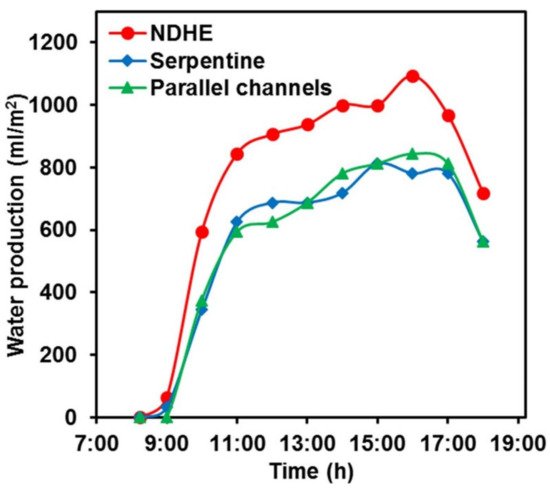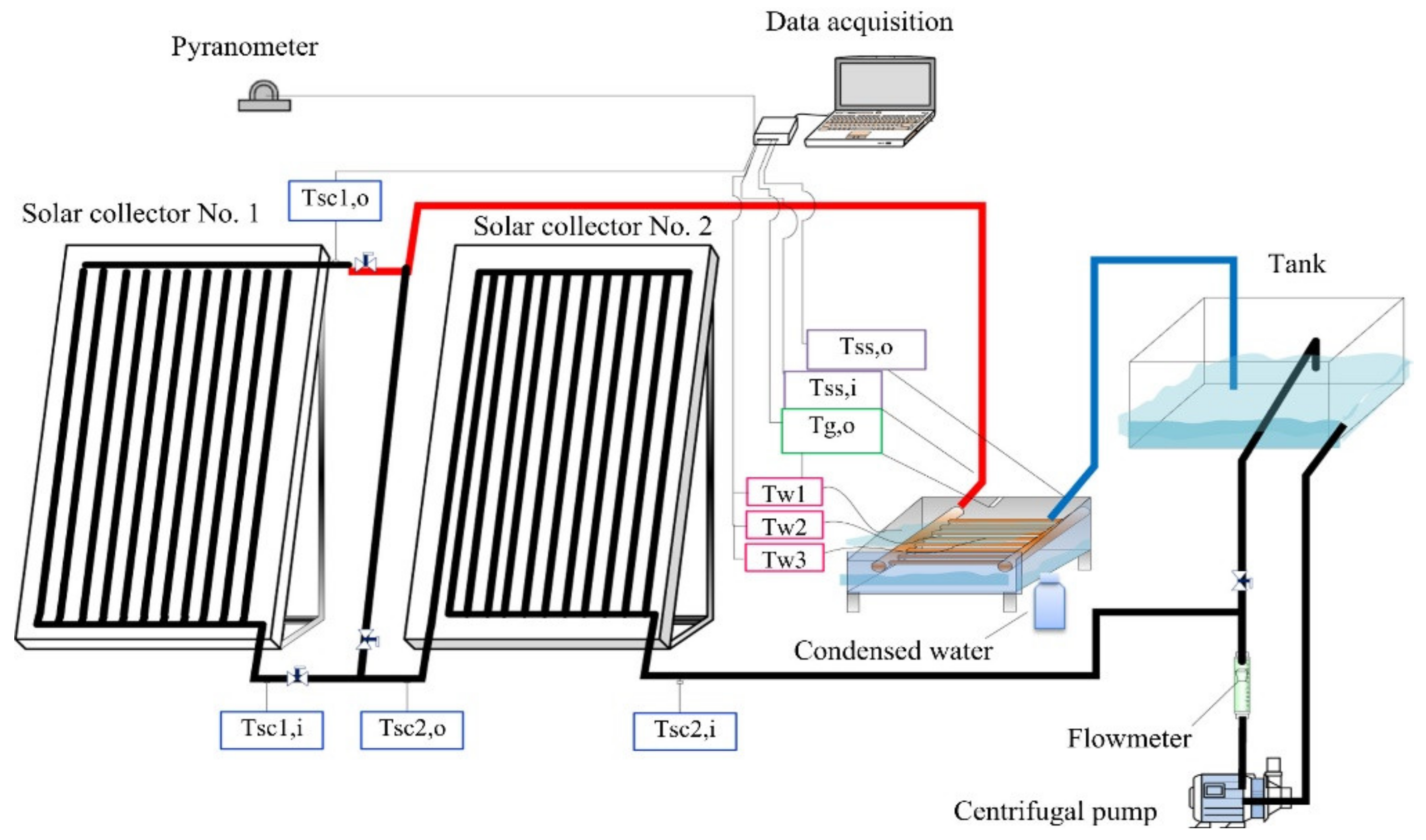You're using an outdated browser. Please upgrade to a modern browser for the best experience.

Submitted Successfully!
Thank you for your contribution! You can also upload a video entry or images related to this topic.
For video creation, please contact our Academic Video Service.
| Version | Summary | Created by | Modification | Content Size | Created at | Operation |
|---|---|---|---|---|---|---|
| 1 | Mahmoud Ahmadein | + 2808 word(s) | 2808 | 2022-03-15 07:45:30 | | | |
| 2 | Bruce Ren | Meta information modification | 2808 | 2022-03-28 04:38:19 | | | | |
| 3 | Bruce Ren | Meta information modification | 2808 | 2022-03-28 07:51:25 | | | | |
| 4 | Bruce Ren | Meta information modification | 2808 | 2022-03-31 11:01:53 | | |
Video Upload Options
We provide professional Academic Video Service to translate complex research into visually appealing presentations. Would you like to try it?
Cite
If you have any further questions, please contact Encyclopedia Editorial Office.
Ahmadein, M. Applications of Heat Exchanger in Solar Desalination. Encyclopedia. Available online: https://encyclopedia.pub/entry/21073 (accessed on 05 January 2026).
Ahmadein M. Applications of Heat Exchanger in Solar Desalination. Encyclopedia. Available at: https://encyclopedia.pub/entry/21073. Accessed January 05, 2026.
Ahmadein, Mahmoud. "Applications of Heat Exchanger in Solar Desalination" Encyclopedia, https://encyclopedia.pub/entry/21073 (accessed January 05, 2026).
Ahmadein, M. (2022, March 25). Applications of Heat Exchanger in Solar Desalination. In Encyclopedia. https://encyclopedia.pub/entry/21073
Ahmadein, Mahmoud. "Applications of Heat Exchanger in Solar Desalination." Encyclopedia. Web. 25 March, 2022.
Copy Citation
Solar desalination is a process to convert saline water into potable water by the application of solar energy. The enhancement of the distillate output of the solar desalination is low, so it is not considered as a method to produce potable water. A heat exchanger is an important device used for heat transfer applications.
solar desalination
solar still
distillate productivity
heat exchanger
1. Introduction
The potable water scarcity problem worsens day by day due to various applications such as drinking, industrial applications and many more [1]. In many areas of the world, people suffer from many diseases due to the scarcity of potable water [2]. The distribution of water on the earth is very uneven [3]. The problem regarding the availability of freshwater to the population is significant in many areas of the world [4]. In African countries, this issue is very critical [5]. The people living in these countries do not have enough suitable drinking water [6]. The earth is predominantly covered with saline water, which is not directly usable for drinking [7]. In order to use seawater for drinking purposes, its salinity must be removed because a salinity level of around 500 ppm is recommended for drinking [8]. Desalination is a simple and easy-to-use technique to remove the impurity/salinity from seawater or brackish water [9]. There are many different techniques available for water cleaning, but solar desalination is the best among them due to its simplicity and non-polluting nature. It is also helpful in areas where there is a shortage of electrical energy resources [10]. This is the reason behind the wide usage of the solar desalination method [11]. Through evaporation and condensation processes, distilled water can be produced from the solar still [12]. Due to high heat losses, solar distillate productivity is still very low [13]. It provides an average of 3 L/day. This is not enough drinking water for a single person [14].
Many researchers have used different methods to lower the heat loss and increase the productivity of solar stills [15][16][17]. They used various techniques such as changing the configuration of the still, changing the solar still design, using a different absorbing material, or introducing components such as flat plate collectors, fins, evacuated tubes, etc. [18][19][20][21]. To increase the evaporative and absorber area, a solar still was modified with an attachment of trays and mirrors inside the still by Essa et al. [22]. A unique solar-geothermal-gas-driven polygeneration system was designed and developed to produce hot water, potable water, combined power, and hydrogen in [23]. Morad et al. [24] reduced the top cover losses by applying a cooling technique. An estimated 30% higher efficiency can be achieved by applying their technique to a solar still. Shyora et al. [25] conducted a similar experiment by modifying a stepped-type solar still and obtained a 23.5% higher efficiency. Panchal and Patel [26] observed that higher wind speeds and solar radiation increase distillate productivity. Badran and Tahaineh [27] used a flat plate collector (FPC). They achieved a 36% higher efficiency compared to a conventional solar still by preheating the water to enhance distillate productivity. Raju and Narayana [28] connected two FPCs in a series to a conventional solar still. They observed a 41% higher distillate productivity. Madiouli et al. [29] used a parabolic trough collector (PTC) and FPC to concentrate solar radiation in a conventional solar still. It has also been found that stills are at their maximum efficiency in summer compared with winter. Fathy et al. [30] experimented using a fixed and movable PTC with a double-slope still to enhance distillate productivity. Panchal [31] conducted an experiment using energy storage materials, such as metal stones and cow dung, and obtained better results. Panchal [32] reviewed different thermal energy storage materials such as black rubber, stones, ink, dyes, charcoal particles, jute wicks, etc. It was found that these materials have good energy-absorbing capacity. Murugavel and Shrithar [33] used a wick material inside the basin area as an absorber to lessen the volumetric heat capacity and enhance the heat transfer area inside the solar still. Omara et al. [34] used fins and corrugated absorber surfaces inside a solar still to improve the distillate productivity. Due to modifications, they achieved a 40% higher distillate productivity than a conventional solar still. Mevada et al. [35] reviewed different attachments of fins and found that increasing the height of the fins resulted an enhanced efficiency of the solar still. Sharshir et al. [36] used evacuated tubes and nanofluids with a pyramid-shaped solar still and compared the experiment with a conventional still. They also measured the performance of copper oxide and carbon black nanomaterial with a solar still. Kumar et al. [37] used a fan to circulate the water from the basin of the solar still to evacuated tubes. They found that the performance of the force mode system is higher than the natural mode. Panchal and Shah [38] experimented on a double-slope-type solar still with evacuated tubes and energy storage materials. They found that a minimum 2 cm basin water depth led to the optimum performance of the solar still.
Climatic parameters such as wind speed and solar intensity also affect the productivity of solar stills [39][40][41]. The performance decreases at lower wind speeds and low solar intensity [42]. To increase the heat transfer coefficient of water, Panchal and Sathyamurthi [43] used porous-type fins. Rajaseenivasan and Shrithar [44] measured the performance of a solar still using square and circular types of fins and found that both fins increase the efficiency of the solar still. Sebaii and Nagar [45] found that the fins’ material did not affect the distillate productivity of the solar still. The productivity of a solar still could also be increased by various parameters reviewed by Panchal and Patel [1]. Diesel engine exhaust gases used with a solar desalination system were evaluated by Panchal Hitesh [38] to enhance distillate productivity. Various heat storage materials and their effects on distillate productivity have been reviewed by Panchal [46]. Nanofluids and their various challenges, applications, heat transport, and other qualities were explained very effectively by Said et al. [47]. A geothermal and solar energy-operated multigeneration system with a thermoelectric generator was proposed by Mahmoudan [48]. Saravanan et al. [49] used a kanchey marble to enhance the distillate productivity of a solar still. They observed that water temperature increases without affecting the phase of the water medium basin, and approximately a 163% higher distillate output could be achieved.
2. Heat Exchanger
A heat exchanger is used to transfer heat between two fluids [50]. It prevents the mixing of two fluids by acting as a separating wall. Heat exchangers are used in solar stills to recover wasted heat, which reduces the heat losses, and are essential from environmental and economic points of view [51].
To increase the inner water temperature and heat transfer capacity of water, a heat exchange medium is used, which preheats the water; hence, the efficiency of a solar still could be improved. In a heat exchanger, the liquid is separately passed into a tube where heat is exchanged between two fluids, and a thermal effect is achieved [52].
3. Solar Desalination System with Heat Exchanger
The efficiency of the solar still is determined by the ratio of the evaporative heat transfer coefficient and the product of the area of the solar still and solar intensity. The evaporative heat transfer coefficient depends on the temperature difference between the water and inner glass. Only solar energy is responsible for raising the temperature in a conventional solar still. However, with the help of a heat exchanger, external hot water is supplied, so the temperature difference will be higher compared with the conventional solar still, and so distillate productivity and efficiency are increased.
Many researchers have used a heat exchanger with a solar still in different ways to increase the distillate output as well as efficiency.
Yadav [53] conducted an experiment using a heat exchanger on a double-slope solar still. He found that the heat exchanger length had a significant effect on the performance of a solar still. He also concluded that the system improved distillate productivity but lessened efficiency.
Chorak et al. [54] developed a heat exchanger for a multi-effect desalination plant that was powered by solar energy. The heat exchangers utilized in the experiment were shell and tube heat exchangers, which allowed them to increase the distillate productivity. The heat transfer coefficients were determined using the Bell method for single-phase heat transfer, the Kandlikar method for boiling correlations, and the Kutateladze method for condensation correlations. They discovered that the technique they employed increased distillate productivity at minimal cost.
To investigate the performance of solar stills, Hosseini et al. [55] conducted an experiment on a solar distillation system with a parabolic trough collector (PTC) with a vacuum-type HE. A schematic diagram of the experimental setup is shown in Figure 1. The oil inside the PTC passed through a pump to the vacuum-type HE. The temperature of the oil and water increased with higher solar intensity (Figure 2), and 1.5 kg/m2/day of distilled water was produced through the system.
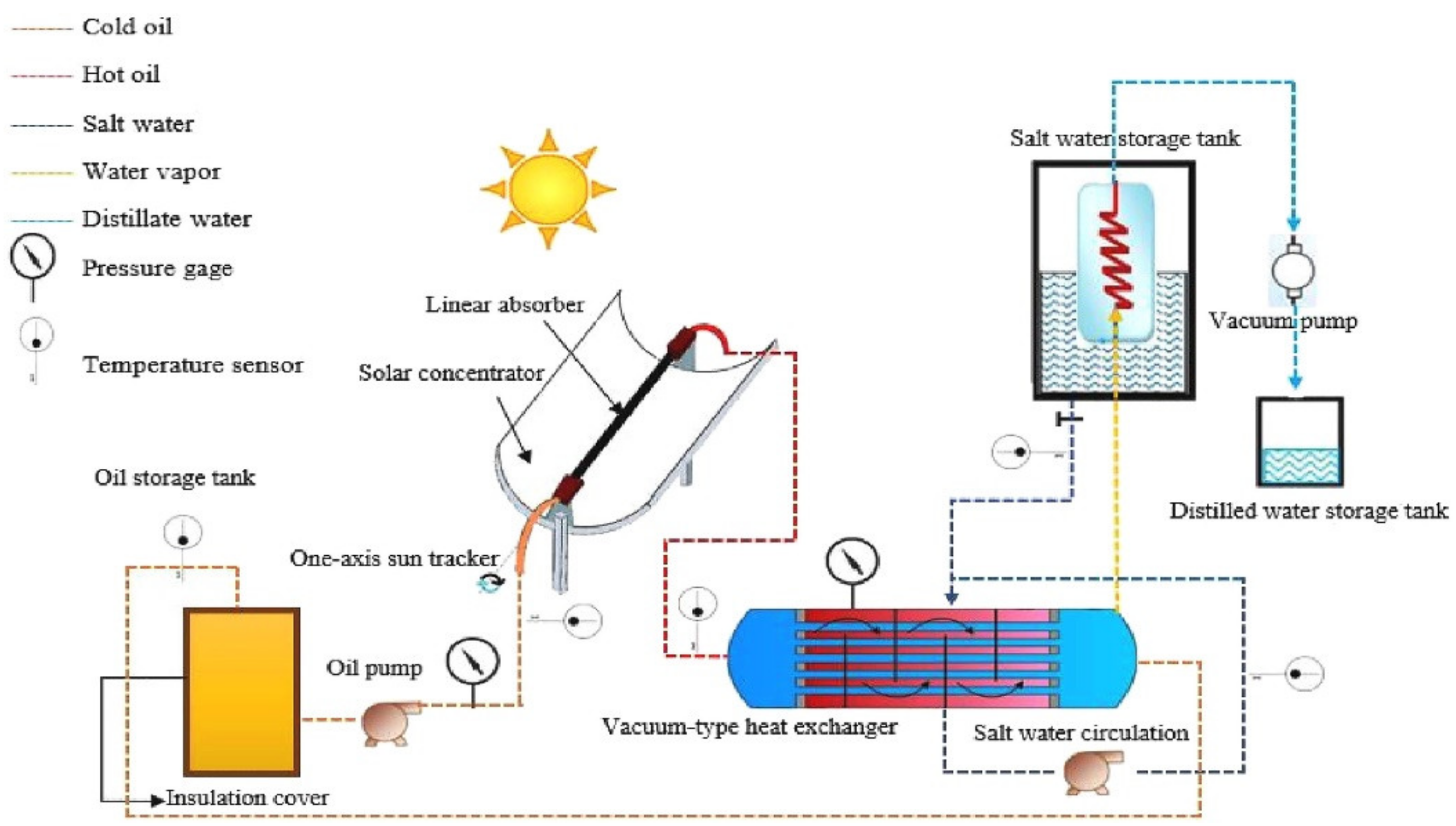
Figure 1. Schematic diagram of solar distillation system integrated with PTC and vacuum-type HE [55].
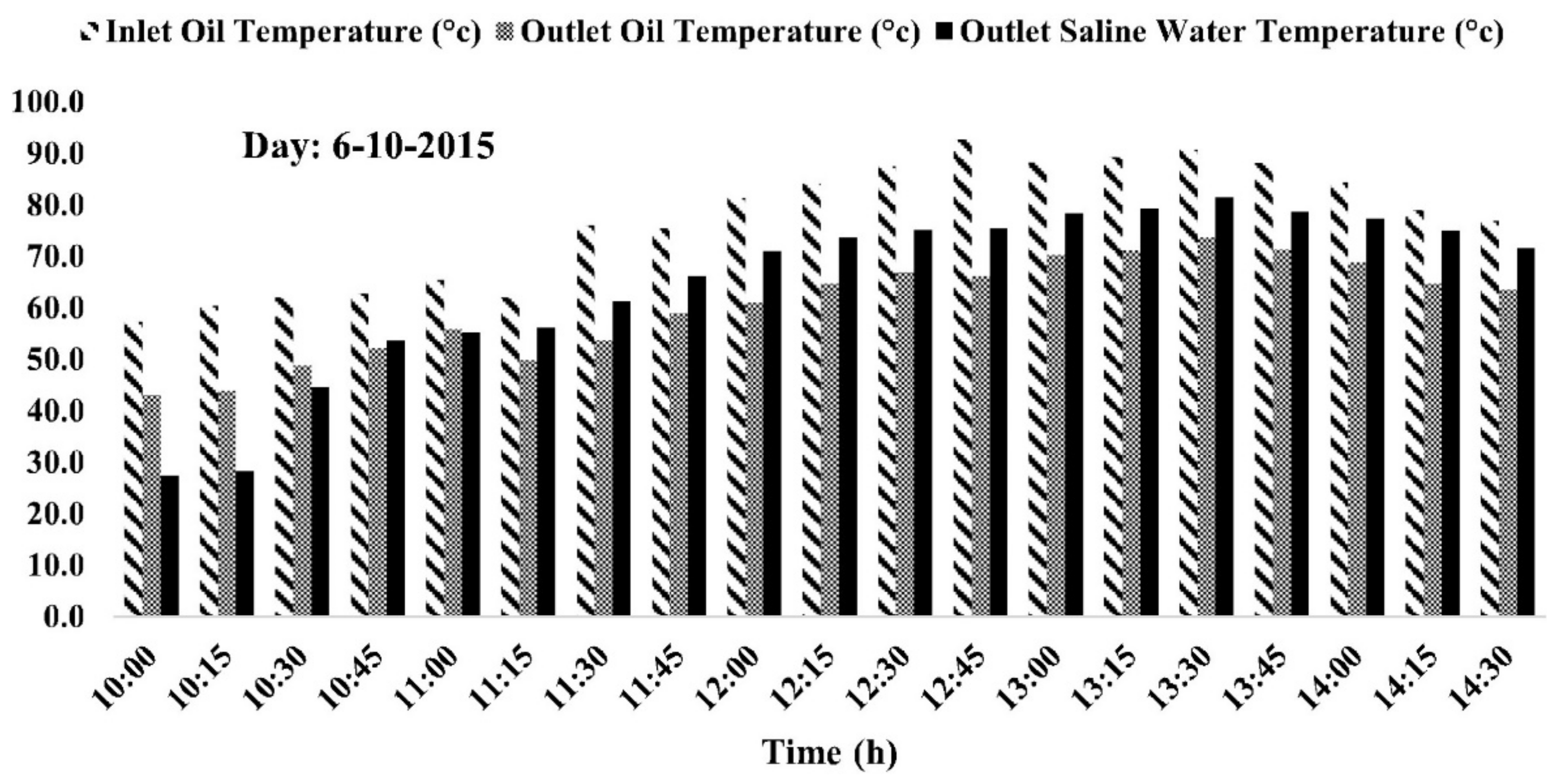
Figure 2. Differentiation in oil and water temperatures inside heat exchanger [55].
Kabeel et al. [56] conducted a review of different heat exchange mechanisms to enhance the performance of solar stills. They found that heat loss could be minimized by minimizing the glass cover temperature or applying the glass-cooling technique. Different thermal energy storage materials ensure a better performance to enhance the day/night distillate productivity of solar stills. Through heat exchange mechanisms, up to 70 °C basin water temperature can be achieved. These modifications of solar stills have a considerable effect on distillate productivity.
Sahota et al. [57] conducted an experiment on a double-slope solar still using a helical coil-type heat exchanger and nanofluids. An evaporative heat transfer coefficient improvement can be achieved with a flat plate collector (FPC) and different nanomaterials such as CuO, Al2O3, and TiO2– metallic nanoparticles (Figure 3). A modification of the system gives a higher value of energy and exergy efficiency. The heat exchanger improved the performance in terms of the distillate productivity of the solar still.
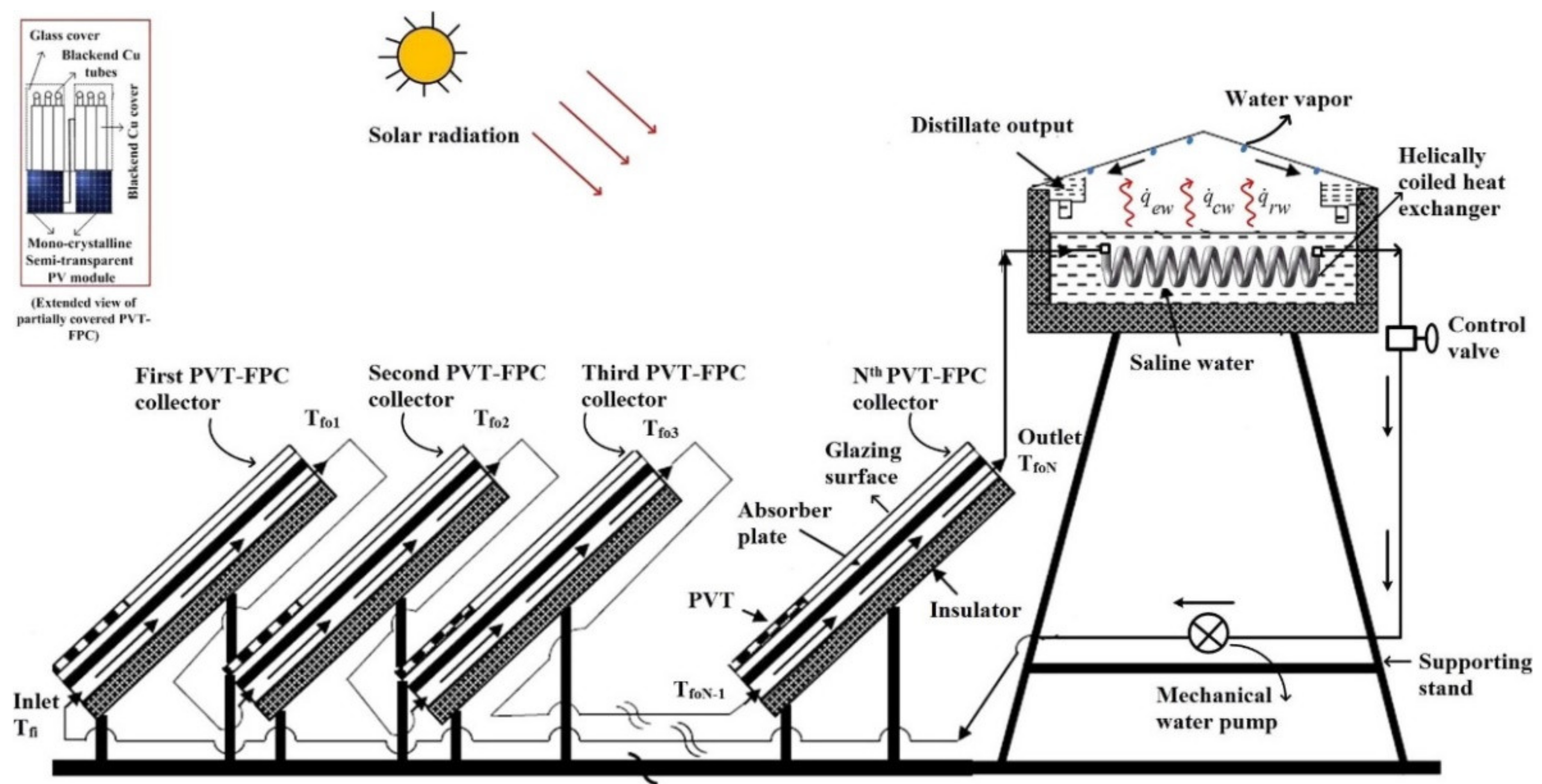
Figure 3. Schematic diagram of double-slope solar still with helical coil heat exchanger and nanofluids [57].
Dhivagar and Sundararaj [58] modified a solar still coupled with a copper material heat exchanger, using a coarse aggregate as an energy-absorbing material, as shown in Figure 4. They concluded that the modification of the solar still produced 28% and 17% higher efficiencies compared with the conventional solar still. For the distillate output, modified and conventional solar stills produced 6.23 and 2.41 kg/m2 (Figure 5). In addition, they achieved higher evaporative and convective heat transfer coefficients due to the modification of the solar still.
Hammadi [59] found that a ground heat exchanger coupled with a solar still benefited soil temperature, as shown in Figure 6. They dipped an HE pipe with a 0.2 m diameter and 70 m length 1 m into the soil. They found that with a greater length and diameter of the pipe, both condensation and evaporation rates decreased due to constant condensation and moisture content. They also received 7.48 and 5 kg/m2 distillate output during experimentation.
Bhargava and Yadav [60] conducted experimental work on a solar still using an HE and evacuated tubes. The problem of scaling on the inner surface of evacuated tubes was avoided with an attachment to the heat exchanger. Experiments were conducted with three different water depths at 4, 5 and 6 cm. The experiment (Figure 7) found that the attachment of the heat exchanger and evacuated tubes ensured the maximum distillate productivity at 4 cm water depth.

Figure 4. Geometry arrangement of finned tube heat exchanger [61].
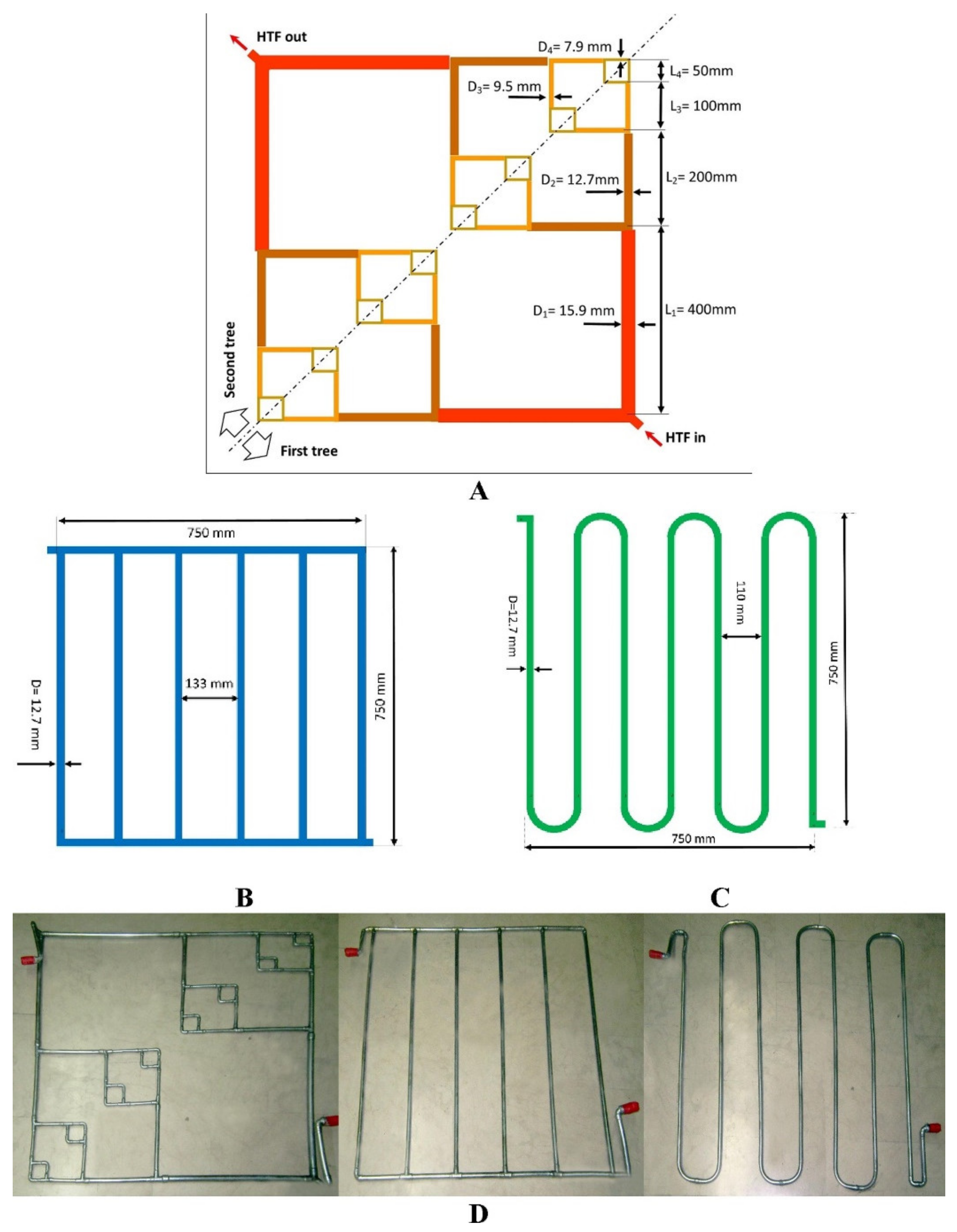
Figure 5. Different designs of heat exchangers: (A) novel design; (B) parallel channel; (C) serpentine design; (D) different designs of heat exchanger [62].
Chaanaoui et al. [61] conducted a comparative analysis for fin configuration on the performance of solar drying applications. A fin tube-type heat exchanger was used for experimental study, as shown in Figure 4. A comparison was made based on fins’ material, geometry, and cost analysis. It was found that a lower number of fins produces a higher evaporation rate. In addition, aluminum materials have good thermal properties, and their cost is lower compared to copper materials, which reduces the total cost of productivity.
Mohammadi et al. [62] conducted a comparative analysis on different designs of heat exchangers with solar stills, as shown in Figure 5. The authors designed a novel shape and compared the performance with parallel-shaped and serpentine heat exchangers. The experiment (Figure 6) found that due to the lower pressure drop, higher volumetric flow rate, and minimum thermal resistance, heat exchangers with novel designs ensure higher freshwater productivity than other shape designs of heat exchangers.
Heat exchangers’ transient performance with double-slope solar stills was investigated by Kumar et al. [63]. An investigation was performed using different parameters such as water depth, mass, heat transfer coefficient, inlet water temperature, etc. The authors found that a higher inlet temperature of water in the HE pipe and lower mass and depth of water lead to a higher efficiency. The distillate output varies with the length of the heat exchanger.
Kumar and Tiwari [64] used wasted heat through the heat exchanger, which is released from the top glass cover to enhance the distillate productivity of solar stills. In their research work, the night performance of the still was improved with the heat exchanger by recovering wasted heat in water inside the solar still.
Mahian et al. [65] investigated the performance of solar stills with heat exchangers and nanomaterials with different concentrations and flow rates. A schematic diagram of the experimental setup is shown in Figure 7. They used SiO2/water and Cu/water as a nanofluid. They found that with a higher concentration of nanofluid and higher inlet temperature of the water with a heat exchanger, a higher heat transfer coefficient could be achieved.
An experimental study to determine the thermal performance of heat exchangers using different soils was performed by Al-Ameen et al. [66]. A ground heat exchanger was developed in this work, and sand was used as the absorber. From the results, it was found that the soil inside the tube increased the temperature of the heat exchanger and heat transfer coefficient too.
Joshi and Tiwari [51] conducted a comparative study to analyze the economic and energy parameters of solar stills with a heat exchanger and a flat plate collector. A comparison was made between fully covered FPCs, partially covered FPCs, and conventional stills. It was observed that systems with fully covered flat plate collectors and heat exchangers produce more distillate water at lower cost and generate more electricity. Table 1 shows the comparison of different Researchers work on solar still with Heat exchanger.
Table 1. Comparison of Different Research Work on solar still with Heat exchanger.
| Author(s) | Configuration | Observations |
|---|---|---|
| Yadav [53] | Double-slope solar still with HE |
|
| Chorak et al. [54] | Shell- and tube-type HE |
|
| Hosseini et al. [55] | PTC and shell- and tube-type HE |
|
| Sahota et al. [57] | Helical coil-type HE |
|
| Dhivagar and Sundararaj [58] | Copper material HE |
|
| Hammadi [58] | Ground Heat exchanger |
|
| Bhargava and Yadav [60] | HE with evacuated tubes |
|
| Chaanaoui et al. [61] | Fin tube-type heat exchanger |
|
| Mohammadi et al. [62] | Novel shape, parallel, serpentine heat exchangers |
|
| Kumar et al. [63] | Double-slope solar still with HE |
|
| Kumar and Tiwari [64] | HE with solar still |
|
| Mahian et al. [65] | Heat exchanger with nanomaterial |
|
| Al-Ameen et al. [66] | Heat exchanger with Soil |
|
| Joshi and Tiwari [51] | Heat exchanger with FPC |
|
References
- Panchal, H.N.; Patel, S. Effect of various parameters on augmentation of distillate output of solar still: A review. Technol. Econ. Smart Grids Sustain. Energy 2016, 1, 1–8.
- Mevada, D.; Panchal, H.; Sadasivuni, K.K. Investigation on evacuated tubes coupled solar still with condenser and fins: Experimental, exergo-economic and exergo-environment analysis. Case Stud. Therm. Eng. 2021, 27, 101217.
- Moustafa, E.B.; Hammad, A.H.; Elsheikh, A.H. A new optimized artificial neural network model to predict thermal efficiency and water yield of tubular solar still. Case Stud. Therm. Eng. 2022, 30, 101750.
- Elsheikh, A.H.; Panchal, H.; Ahmadein, M.; Mosleh, A.O.; Sadasivuni, K.K.; Alsaleh, N.A. Productivity forecasting of solar distiller integrated with evacuated tubes and external condenser using artificial intelligence model and moth-flame optimizer. Case Stud. Therm. Eng. 2021, 28, 101671.
- Elsheikh, A.H.; Shanmugan, S.; Sathyamurthy, R.; Kumar Thakur, A.; Issa, M.; Panchal, H.; Muthuramalingam, T.; Kumar, R.; Sharifpur, M. Low-cost bilayered structure for improving the performance of solar stills: Performance/cost analysis and water yield prediction using machine learning. Sustain. Energy Technol. Assess. 2022, 49, 101783.
- Shanmugan, S.; Essa, F.; Gorjian, S.; Kabeel, A.; Sathyamurthy, R.; Manokar, A.M. Experimental study on single slope single basin solar still using TiO2 nano layer for natural clean water invention. J. Energy Storage 2020, 30, 101522.
- Elsheikh, A.H.; Sharshir, S.W.; Mostafa, M.E.; Essa, F.A.; Ahmed Ali, M.K. Applications of nanofluids in solar energy: A review of recent advances. Renew. Sustain. Energy Rev. 2018, 82, 3483–3502.
- Pansal, K.; Ramani, B.; Kumar Sadasivuni, K.; Panchal, H.; Manokar, M.; Sathyamurthy, R.; Suresh, M.; Israr, M. Use of solar photovoltaic with active solar still to improve distillate output: A review. Groundw. Sustain. Dev. 2020, 10, 100341.
- Elsheikh, A.H.; Sharshir, S.W.; Ahmed Ali, M.K.; Shaibo, J.; Edreis, E.M.A.; Abdelhamid, T.; Du, C.; Haiou, Z. Thin film technology for solar steam generation: A new dawn. Sol. Energy 2019, 177, 561–575.
- Panchal, H. Annual performance analysis of various energy storage materials in the upper basin of a double-basin solar still with vacuum tubes. Int. J. Ambient Energy 2020, 41, 435–451.
- Elsheikh, A.H.; Katekar, V.P.; Muskens, O.L.; Deshmukh, S.S.; Elaziz, M.A.; Dabour, S.M. Utilization of LSTM neural network for water production forecasting of a stepped solar still with a corrugated absorber plate. Process. Saf. Environ. Prot. 2021, 148, 273–282.
- Sharshir, S.W.; Elsheikh, A.H.; Peng, G.; Yang, N.; El-Samadony, M.O.A.; Kabeel, A.E. Thermal performance and exergy analysis of solar stills—A review. Renew. Sustain. Energy Rev. 2017, 73, 521–544.
- Patel, M.; Patel, C.; Panchal, H. Performance analysis of conventional triple basin solar still with evacuated heat pipes, corrugated sheets and storage materials. Groundw. Sustain. Dev. 2020, 11, 100387.
- Abd Elaziz, M.; Essa, F.A.; Elsheikh, A.H. Utilization of ensemble random vector functional link network for freshwater prediction of active solar stills with nanoparticles. Sustain. Energy Technol. Assess. 2021, 47, 101405.
- Panchal, H.; Mohan, I. Various methods applied to solar still for enhancement of distillate output. Desalination 2017, 415, 76–89.
- Gandhi, A.M.; Shanmugan, S.; Gorjian, S.; Pruncu, C.I.; Sivakumar, S.; Elsheikh, A.H.; Essa, F.A.; Omara, Z.M.; Panchal, H. Performance enhancement of stepped basin solar still based on OSELM with traversal tree for higher energy adaptive control. Desalination 2021, 502, 114926.
- Gandhi, A.M.; Shanmugan, S.; Kumar, R.; Elsheikh, A.H.; Sharifpur, M.; Bewoor, A.K.; Bamisile, O.; Hoang, A.T.; Ongar, B. SiO2/TiO2 nanolayer synergistically trigger thermal absorption inflammatory responses materials for performance improvement of stepped basin solar stillnatural distiller. Sustain. Energy Technol. Assess. 2022, 52, 101974.
- AbuShanab, W.S.; Elsheikh, A.H.; Ghandourah, E.I.; Moustafa, E.B.; Sharshir, S.W. Performance improvement of solar distiller using hang wick, reflectors and phase change materials enriched with nano-additives. Case Stud. Therm. Eng. 2022, 31, 101856.
- Sharshir, S.W.; Peng, G.; Wu, L.; Yang, N.; Essa, F.A.; Elsheikh, A.H.; Mohamed, S.I.T.; Kabeel, A.E. Enhancing the solar still performance using nanofluids and glass cover cooling: Experimental study. Appl. Therm. Eng. 2017, 113, 684–693.
- Sharshir, S.W.; Ellakany, Y.M.; Algazzar, A.M.; Elsheikh, A.H.; Elkadeem, M.R.; Edreis, E.M.A.; Waly, A.S.; Sathyamurthy, R.; Panchal, H.; Elashry, M.S. A mini review of techniques used to improve the tubular solar still performance for solar water desalination. Process. Saf. Environ. Prot. 2019, 124, 204–212.
- Elsheikh, A.H.; Sharshir, S.W.; Abd Elaziz, M.; Kabeel, A.E.; Guilan, W.; Haiou, Z. Modeling of solar energy systems using artificial neural network: A comprehensive review. Sol. Energy 2019, 180, 622–639.
- Essa, F.A.; Omara, Z.M.; Abdullah, A.S.; Shanmugan, S.; Panchal, H.; Kabeel, A.E.; Sathyamurthy, R.; Alawee, W.H.; Manokar, A.M.; Elsheikh, A.H. Wall-suspended trays inside stepped distiller with Al2O3/paraffin wax mixture and vapor suction: Experimental implementation. J. Energy Storage 2020, 32, 102008.
- Manesh, M.K.; Rabeti, S.M.; Nourpour, M.; Said, Z. Energy, exergy, exergoeconomic, and exergoenvironmental analysis of an innovative solar-geothermal-gas driven polygeneration system for combined power, hydrogen, hot water, and freshwater production. Sustain. Energy Technol. Assess. 2022, 51, 101861.
- Morad, M.; El-Maghawry, H.A.; Wasfy, K.I. Improving the double slope solar still performance by using flat-plate solar collector and cooling glass cover. Desalination 2015, 373, 1–9.
- Shyora, A.; Patel, K.; Panchal, H. Comparative analysis of stepped and single basin solar still in climate conditions of Gandhinagar Gujarat during winter. Int. J. Ambient Energy 2021, 42, 1649–1659.
- Panchal, H.N.; Patel, S. An extensive review on different design and climatic parameters to increase distillate output of solar still. Renew. Sustain. Energy Rev. 2017, 69, 750–758.
- Badran, O.; Al-Tahaineh, H. The effect of coupling a flat-plate collector on the solar still productivity. Desalination 2005, 183, 137–142.
- Raju, V.R.; Narayana, R.L. Effect of flat plate collectors in series on performance of active solar still for Indian coastal climatic condition. J. King Saud Univ.-Eng. Sci. 2018, 30, 78–85.
- Madiouli, J.; Lashin, A.; Shigidi, I.; Badruddin, I.A.; Kessentini, A. Experimental study and evaluation of single slope solar still combined with flat plate collector, parabolic trough and packed bed. Sol. Energy 2020, 196, 358–366.
- Fathy, M.; Hassan, H.; Ahmed, M.S. Experimental study on the effect of coupling parabolic trough collector with double slope solar still on its performance. Sol. Energy 2018, 163, 54–61.
- Panchal, H.N. Performance analysis of solar still with cow dung cakes and blue metal stones. Front. Energy 2015, 9, 180–186.
- Panchal, H.N. Use of thermal energy storage materials for enhancement in distillate output of solar still: A review. Renew. Sustain. Energy Rev. 2016, 61, 86–96.
- Murugavel, K.K.; Srithar, K. Performance study on basin type double slope solar still with different wick materials and minimum mass of water. Renew. Energy 2011, 36, 612–620.
- Omara, Z.; Hamed, M.H.; Kabeel, A. Performance of finned and corrugated absorbers solar stills under Egyptian conditions. Desalination 2011, 277, 281–287.
- Mevada, D.; Panchal, H.; Kumar Sadasivuni, K.; Israr, M.; Suresh, M.; Dharaskar, S.; Thakkar, H. Effect of fin configuration parameters on performance of solar still: A review. Groundw. Sustain. Dev. 2020, 10, 100289.
- Sharshir, S.W.; Kandeal, A.; Ismail, M.; Abdelaziz, G.B.; Kabeel, A.; Yang, N. Augmentation of a pyramid solar still performance using evacuated tubes and nanofluid: Experimental approach. Appl. Therm. Eng. 2019, 160, 113997.
- Kumar, S.; Dubey, A.; Tiwari, G. A solar still augmented with an evacuated tube collector in forced mode. Desalination 2014, 347, 15–24.
- Panchal, H.N.; Shah, P.K. Enhancement of upper basin distillate output by attachment of vacuum tubes with double-basin solar still. Desalinat. Water Treat. 2015, 55, 587–595.
- Sharshir, S.W.; Elsheikh, A.H.; Edreis, E.M.A.; Ali, M.K.A.; Sathyamurthy, R.; Kabeel, A.E.; Zang, J.; Yang, N. Improving the solar still performance by using thermal energy storage materials: A review of recent developments. Desalinat. Water Treat. 2019, 165, 1–15.
- Mevada, D.; Panchal, H.; Ahmadein, M.; Zayed, M.E.; Alsaleh, N.A.; Djuansjah, J.; Moustafa, E.B.; Elsheikh, A.H.; Sadasivuni, K.K. Investigation and performance analysis of solar still with energy storage materials: An energy-exergy efficiency analysis. Case Stud. Therm. Eng. 2022, 29, 101687.
- Elsheikh, A.; Sharshir, S.; Kabeel, A.; Sathyamurthy, R. Application of Taguchi method to determine the optimal water depth and glass cooling rate in solar stills. Sci. Iran. 2021, 28, 731–742.
- Ghandourah, E.I.; Sangeetha, A.; Shanmugan, S.; Zayed, M.E.; Moustafa, E.B.; Tounsi, A.; Elsheikh, A.H. Performance assessment of a novel solar distiller with a double slope basin covered by coated wick with lanthanum cobalt oxide nanoparticles. Case Stud. Therm. Eng. 2022, 101859.
- Panchal, H.; Sathyamurthy, R. Experimental analysis of single-basin solar still with porous fins. Int. J. Ambient Energy 2020, 41, 563–569.
- Rajaseenivasan, T.; Srithar, K. Performance investigation on solar still with circular and square fins in basin with CO2 mitigation and economic analysis. Desalination 2016, 380, 66–74.
- El-Sebaii, A.; El-Naggar, M. Year round performance and cost analysis of a finned single basin solar still. Appl. Therm. Eng. 2017, 110, 787–794.
- Panchal, H.; Patel, V.; Prajapati, V.; Patel, D.; Patel, H.; Patel, S. Experimental analysis of diesel engine exhaust gas coupled with water desalination for improved potable water production. In Proceedings of the ASME International Mechanical Engineering Congress and Exposition, Houston, TX, USA, 13–19 November 2015; pp. 1–5.
- Said, Z.; Sundar, L.S.; Tiwari, A.K.; Ali, H.M.; Sheikholeslami, M.; Bellos, E.; Babar, H. Recent advances on the fundamental physical phenomena behind stability, dynamic motion, thermophysical properties, heat transport, applications, and challenges of nanofluids. Phys. Rep. 2021, 946, 1–94.
- Mahmoudan, A.; Esmaeilion, F.; Hoseinzadeh, S.; Soltani, M.; Ahmadi, P.; Rosen, M. A geothermal and solar-based multigeneration system integrated with a TEG unit: Development, 3E analyses, and multi-objective optimization. Appl. Energy 2022, 308, 118399.
- Saravanan, N.M.; Rajakumar, S.; Moshi, A.A.M. Experimental investigation on the performance enhancement of single basin double slope solar still using kanchey marbles as sensible heat storage materials. Mater. Today Proc. 2021, 39, 1600–1604.
- El-Said, E.M.S.; Abd Elaziz, M.; Elsheikh, A.H. Machine learning algorithms for improving the prediction of air injection effect on the thermohydraulic performance of shell and tube heat exchanger. Appl. Therm. Eng. 2021, 185, 116471.
- Joshi, P.; Tiwari, G.N. Energy matrices, exergo-economic and enviro-economic analysis of an active single slope solar still integrated with a heat exchanger: A comparative study. Desalination 2018, 443, 85–98.
- El-Said, E.M.S.; Elsheikh, A.H.; El-Tahan, H.R. Effect of curved segmental baffle on a shell and tube heat exchanger thermohydraulic performance: Numerical investigation. Int. J. Therm. Sci. 2021, 165.
- Yadav, Y.P. Performance analysis of a solar still coupled to a heat exchanger. Desalination 1993, 91, 135–144.
- Chorak, A.; Maakoul, A.E.; Laknizi, A.; Abdellah, A.B.; Essadiqi, E. Modeling and design of heat exchangers in a solar-multi effect distillation plant. In Proceedings of the 2015 3rd International Renewable and Sustainable Energy Conference (IRSEC), Marrakech, Morocco, 10–13 December 2015; pp. 1–6.
- Hosseini, A.; Banakar, A.; Gorjian, S. Development and performance evaluation of an active solar distillation system integrated with a vacuum-type heat exchanger. Desalination 2018, 435, 45–59.
- Kabeel, A.E.; Arunkumar, T.; Denkenberger, D.C.; Sathyamurthy, R. Performance enhancement of solar still through efficient heat exchange mechanism—A review. Appl. Therm. Eng. 2017, 114, 815–836.
- Sahota, L.; Tiwari, G.N. Analytical characteristic equation of nanofluid loaded active double slope solar still coupled with helically coiled heat exchanger. Energy Convers. Manag. 2017, 135, 308–326.
- Dhivagar, R.; Sundararaj, S. Thermodynamic and water analysis on augmentation of a solar still with copper tube heat exchanger in coarse aggregate. J. Therm. Anal. Calorim. 2019, 136, 89–99.
- Hammadi, S.H. Integrated solar still with an underground heat exchanger for clean water production. J. King Saud Univ-Eng. Sci. 2020, 32, 339–345.
- Bhargva, M.; Yadav, A. Experimental comparative study on a solar still combined with evacuated tubes and a heat exchanger at different water depths. Int. J. Sustain. Eng. 2020, 13, 218–229.
- Chaanaoui, M.; Ettahi, K.; Abderafi, S.; Vaudreuil, S.; Bounahmidi, T. Comparative analysis between optimum configurations of finned tube heat exchanger: Application for solar drying. Case Stud. Therm. Eng. 2020, 22, 100750.
- Mohammadi, K.; Taghvaei, H.; Rad, E.G. Experimental investigation of a double slope active solar still: Effect of a new heat exchanger design performance. Appl. Therm. Eng. 2020, 180, 115875.
- Kumar, A.; Singh, M.; Anand, J.D. Transient performance of a double-basin solar still integrated with a heat exchanger. Energy 1989, 14, 643–652.
- Kumar, A.; Tiwari, G.N. Use of waste hot water in double slope solar still through heat exchanger. Energy Convers. Manag. 1990, 30, 81–89.
- Mahian, O.; Kianifar, A.; Heris, S.Z.; Wen, D.; Sahin, A.Z.; Wongwises, S. Nanofluids effects on the evaporation rate in a solar still equipped with a heat exchanger. Nano Energy 2017, 36, 134–155.
- Al-Ameen, Y.; Ianakiev, A.; Evans, R. Thermal performance of a solar assisted horizontal ground heat exchanger. Energy 2017, 140, 1216–1227.
More
Information
Subjects:
Energy & Fuels
Contributor
MDPI registered users' name will be linked to their SciProfiles pages. To register with us, please refer to https://encyclopedia.pub/register
:
View Times:
2.2K
Revisions:
4 times
(View History)
Update Date:
31 Mar 2022
Notice
You are not a member of the advisory board for this topic. If you want to update advisory board member profile, please contact office@encyclopedia.pub.
OK
Confirm
Only members of the Encyclopedia advisory board for this topic are allowed to note entries. Would you like to become an advisory board member of the Encyclopedia?
Yes
No
${ textCharacter }/${ maxCharacter }
Submit
Cancel
Back
Comments
${ item }
|
More
No more~
There is no comment~
${ textCharacter }/${ maxCharacter }
Submit
Cancel
${ selectedItem.replyTextCharacter }/${ selectedItem.replyMaxCharacter }
Submit
Cancel
Confirm
Are you sure to Delete?
Yes
No


